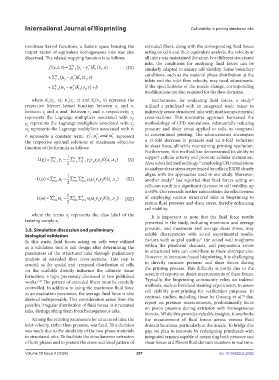Page 265 - IJB-10-4
P. 265
International Journal of Bioprinting Cell viability in printing structured inks
nonlinear kernel functions, a feature space housing the extruded fibers, along with the corresponding fluid forces
output vector of equivalent homogeneous inks was also acting on cells and their equivalent analysis, the velocity at
discerned. The related mapping function is as follows: all inlets was maintained the same. For different structured
inks, the conditions for analyzing fluid forces can be
k
− µ
(, )v +
fx zv(, ,) =∑ n i=1 ( −γ i γ i ∗ ) Kx x(, )+ ∑ m j=1 (µ j (IX) ∗ j ) K zz( ,)+∑ ((w − w l ∗ )Kv l b
j similarly adapted to ensure cell viability. Some boundary
1
1
1
l=1
l
i
k
(, )v +
fx zv(, ,) =∑ n i=1 ( −γ i γ ∗ ) Kx x(, )+ ∑ m j=1 (µ j − µ ∗ j ) K zz( ,)+∑ ((w − w l ∗ )Kv l b conditions, such as the material phase distribution at the
l=1
1
i
i
l
j
1
1
inlets and the inlet flow velocity, may need adjustments.
fx zv(, ,) =∑ n i=1 ( −γ i γ i ∗ ) Kx x(, )+ ∑ m j=1 (µ j − µ ∗ ) K zz( ,)+∑ ((w − w ∗ l )Kv l b If the specifications of the nozzle change, corresponding
(, )v +
k
j
1
l=1
1
i
j
l
1
modifications are also required for the flow domains.
where K (x , x), K (z , z) and K(v , v) represent the Furthermore, for evaluating fluid forces, a study
34
i
l
l
i
1
1
respective Mercer kernel function between x and x, utilized a printhead with an integrated static mixer to
i
between z and z, and between v and v, respectively; γ i indirectly create structured inks with multicompartmental
j
l
represents the Lagrange multipliers associated with x ; cross-sections. This innovative approach harnessed the
i
μ represents the Lagrange multipliers associated with z ; methodology of CFD simulations, substantially reducing
j
i
w represents the Lagrange multipliers associated with v; pressure and shear stress applied to cells, as compared
l
∗
∗
∗
b represents a constant term; γ , µ and, ω represent to conventional printing. The advancements encompass
j
l
i
the respective optimal solutions of maximum objective a 15-fold decrease in pressure and an 8-fold reduction
function of the formula as follows: in shear force, all while maintaining printing resolution.
Furthermore, this method has demonstrated its ability to
1
L()χ =∑ n i=1 γ −∑ n i=1 ∑ n j=1 γγ j y yK xx(, ) (X) support cellular activity and promote cellular maturation.
i
i
i
j
j
i
2
Also, a detailed methodology, employing CFD simulations
39
to analyze shear stress experienced by cells in E3DP, closely
1 aligns with the approaches used in our study. Moreover,
L()µ =∑ m µ −∑ m ∑ m j=1 µµ j y yK zz(, ) (XI) another study has reported that fluid forces acting on
52
i
j
i
i=1
i
i
i=1
j
2
cells can result in a significant decrease in cell viability, up
to 60%. Our research further substantiates the effectiveness
1
L()ω =∑ k i=1 ω −∑ k i=1 ∑ k j=1 ωω j y yK vv(, ) (XII) of employing various structured inks in bioprinting to
j
i
j
i
i
i
2
reduce fluid pressure and shear stress, thereby enhancing
cell viability.
where the terms y represents the class label of the It is important to note that the fluid force results
i
training sample x . i presented in the study, including maximum and average
3.8. Simulation discussion and preliminary pressure, and maximum and average shear stress, may
biological validation exhibit discrepancies with actual experimental results.
53
In this study, fluid forces acting on cells were utilized Factors such as grid quality, the actual wall roughness
as a validation tool in ink design after determining the within the printhead channels, and preparation errors
parameters of the structured inks through preliminary in structured inks can contribute to these discrepancies.
analysis of extruded fiber cross-sections. This step is However, in extrusion-based bioprinting, it is challenging
crucial, as the spatial and temporal distribution of cells to directly measure pressure and shear forces during
on the scaffolds directly influence the ultimate tissue the printing process. This difficulty is partly due to the
formation, a topic previously discussed in two published scarcity of reports on direct measurements of these forces.
works. The pattern of extruded fibers must be carefully Typically, the bioprinting community relies on indirect
6,10
controlled. In addition to using the maximum fluid force methods, such as live/dead staining experiments, to assess
as an evaluation parameter, the average fluid force is also cell viability post-printing for verification purposes. In
54
deemed indispensable. This consideration arises from the contrast, studies, including those by Ouyang et al. that
possible irregular distribution of fluid forces in structured report on pressure measurements, predominantly focus
on piston pressure during extrusion with homogeneous
inks, distinguishing them from homogeneous inks.
bioinks. While this provides valuable insights, it overlooks
Among the printing parameters for structured inks, the the measurement of fluid forces across various fluid
inlet velocity, rather than pressure, was fixed. This decision domain locations, particularly at the nozzle. To bridge this
was made due to the similarity of the two-phase materials gap, we plan to innovate by redesigning printheads with
in structured inks. To facilitate the simultaneous extrusion integrated sensors capable of measuring both pressure and
of both phases and to present the cross-sectional pattern of shear forces at different fluid domain locations in real time.
Volume 10 Issue 4 (2024) 257 doi: 10.36922/ijb.2362

